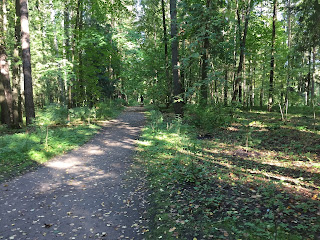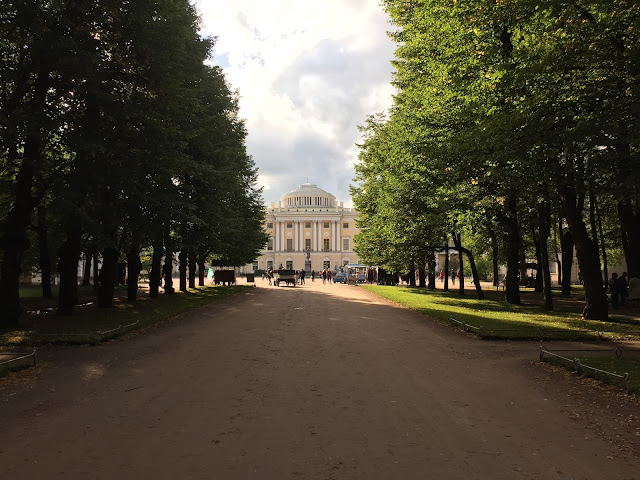128. Pavlovsk Park
Just as at Gatchina Palace, more Russian tourists and locals visit the surrounding park rather than Pavlosk Palace itself. The park includes what is alleged to be among the largest landscaped gardens in Russia, if not the world (over 607 hectares, including several wooded areas). The gardens spread for several kilometers to the west, east, and north of the Palace. The weather was nice so it was fun to explore the area. I must have walked around for two or three hours but only managed to see approximately twenty percent of the park, so it's clear why people enjoy coming here on a regular basis. Several of the paths were a bit muddy after several days of rain during the previous week, but not so bad as to prevent safe passage.
I made an effort to visit as many of the follies and other points of interest as I could find. Many of them are located on one side or the other of the Slavyanka River. The impressive Italian Staircase leads from the Palace down to the river. It was designed in 1799 by Vincenzo Brenna. The Temple of Friendship is visible from the bottom of the stairs. It was designed in 1780-1782 by Charles Cameron. Sadly, the doors were locked so I did not see the small sculpture hall inside. A short walk to the east across the river took me to the Old Sylvia parkland, also known as Twelve Paths. This area contains numerous bronze statues - generally late eighteenth century copies of Greek originals. The statues - Apollo, the nine Muses, Venus, Flora, Mercury, four Niobids, the Bhorgese Warrior, and Actaeon - were installed in the garden in 1798-1799. I believe I found all of them and they're pictured below.
Walking further east along the river brought me to the Rose Pavilion, perhaps a 15-minute stroll from the Palace. This building was designed by Andrey Voronikhin in 1811, destroyed by the Nazis during the Great Patriotic War, and rebuilt to the original specifications in the 1990s. The original building was one of Maria Feodorovna's favorite places to spend time with her friends and family. I was impressed by both the natural roses outside and the rose decorations inside the ballroom.
The White Birch Circle was the reward at the end of a 30-minute walk northeast from the Rose Pavilion, along a series of muddy tracks. Back to the west, and north of the Old Sylvia area, is the New Sylvia woodland. Hidden in the middle of the forest here is the Mausoleum of Paul I. This was built in 1806-1810, but is not the final resting place of the Emperor - he is buried in the Peter and Paul Cathedral along with most of the rest of the Romanov Tsars. The "Land's End" column (1784 design by Charles Cameron), the Peel Tower (1795, Vincenzo Brenna), and the Peel Tower Bridge (1808, Andrey Voronikhin) rounded out my hike back to the Palace. One could certainly spend an entire day here - there was a small lake with boats for hire, several cafes, and a variety of other follies and monuments on the western side of the park that I did not see.
The Temple of Friendship:
"Old Sylvia", also known as Twelve Paths:
Bronze sculpture garden in Old Sylvia:
The Rose Pavilion:
The White Birch circle:
Two of the "alleys" in the White Birch area:
Mausoleum of Paul I:
Peel Tower and the Peel Tower Bridge:
Views of Pavlosk Palace from the Gardens:
I made an effort to visit as many of the follies and other points of interest as I could find. Many of them are located on one side or the other of the Slavyanka River. The impressive Italian Staircase leads from the Palace down to the river. It was designed in 1799 by Vincenzo Brenna. The Temple of Friendship is visible from the bottom of the stairs. It was designed in 1780-1782 by Charles Cameron. Sadly, the doors were locked so I did not see the small sculpture hall inside. A short walk to the east across the river took me to the Old Sylvia parkland, also known as Twelve Paths. This area contains numerous bronze statues - generally late eighteenth century copies of Greek originals. The statues - Apollo, the nine Muses, Venus, Flora, Mercury, four Niobids, the Bhorgese Warrior, and Actaeon - were installed in the garden in 1798-1799. I believe I found all of them and they're pictured below.
Walking further east along the river brought me to the Rose Pavilion, perhaps a 15-minute stroll from the Palace. This building was designed by Andrey Voronikhin in 1811, destroyed by the Nazis during the Great Patriotic War, and rebuilt to the original specifications in the 1990s. The original building was one of Maria Feodorovna's favorite places to spend time with her friends and family. I was impressed by both the natural roses outside and the rose decorations inside the ballroom.
The White Birch Circle was the reward at the end of a 30-minute walk northeast from the Rose Pavilion, along a series of muddy tracks. Back to the west, and north of the Old Sylvia area, is the New Sylvia woodland. Hidden in the middle of the forest here is the Mausoleum of Paul I. This was built in 1806-1810, but is not the final resting place of the Emperor - he is buried in the Peter and Paul Cathedral along with most of the rest of the Romanov Tsars. The "Land's End" column (1784 design by Charles Cameron), the Peel Tower (1795, Vincenzo Brenna), and the Peel Tower Bridge (1808, Andrey Voronikhin) rounded out my hike back to the Palace. One could certainly spend an entire day here - there was a small lake with boats for hire, several cafes, and a variety of other follies and monuments on the western side of the park that I did not see.
The Italian Staircase:
The Temple of Friendship:
"Old Sylvia", also known as Twelve Paths:
Bronze sculpture garden in Old Sylvia:
The Rose Pavilion:
The White Birch circle:
Two of the "alleys" in the White Birch area:
Mausoleum of Paul I:
The "Land's End" column:
Peel Tower and the Peel Tower Bridge:
Views of Pavlosk Palace from the Gardens:
























































































Comments
Post a Comment